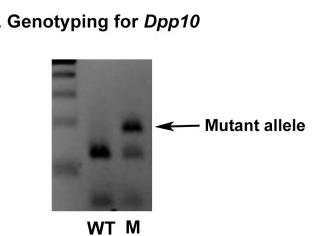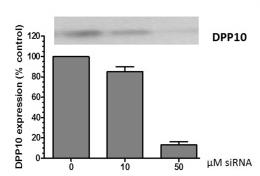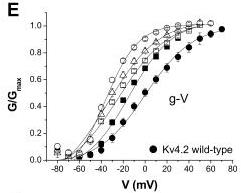Recombinant Human DPP10 protein(Leu56-Glu796), His-tagged
| Cat.No. : | DPP10-943H |
| Product Overview : | Recombinant Human DPP10 isoform 1 (Q8N608-1) (Leu 56-Glu 796) was expressed in HEK293, with a polyhistidine tag at the N-terminus. |
| Availability | March 31, 2025 |
| Unit | |
| Price | |
| Qty |
- Specification
- Gene Information
- Related Products
- Case Study
- Application
- Download
| Species : | Human |
| Source : | HEK293 |
| Tag : | His |
| Protein Length : | 56-796 a.a. |
| Form : | Lyophilized from sterile PBS, pH 7.4. Normally 5 % - 8 % trehalose, mannitol and 0.01% Tween80 are added as protectants before lyophilization. |
| Molecular Mass : | The recombinant human DPP10 consists of 760 amino acids and has a calculated molecular mass of 87.4 kDa. In SDS-PAGE under reducing conditions, the apparent molecular mass of rhDPP10 is approximately 90-110 kDa due to glycosylation. |
| Endotoxin : | < 1.0 EU per μg of the protein as determined by the LAL method |
| Purity : | > 97 % as determined by SDS-PAGE |
| Storage : | Samples are stable for up to twelve months from date of receipt at -20°C to -80°C. Store it under sterile conditions at -20°C to -80°C. It is recommended that the protein be aliquoted for optimal storage. Avoid repeated freeze-thaw cycles. |
| Reconstitution : | It is recommended that sterile water be added to the vial to prepare a stock solution of 0.2 ug/ul. Centrifuge the vial at 4°C before opening to recover the entire contents. |
| Gene Name | DPP10 dipeptidyl-peptidase 10 (non-functional) [ Homo sapiens ] |
| Official Symbol | DPP10 |
| Synonyms | DPP10; dipeptidyl-peptidase 10 (non-functional); dipeptidyl peptidase 10 , dipeptidylpeptidase 10; inactive dipeptidyl peptidase 10; DPRP3; DPP X; DPRP-3; dipeptidyl peptidase X; dipeptidyl peptidase 10; dipeptidyl peptidase like protein 2; dipeptidyl peptidase-like protein 2; dipeptidyl peptidase IV-related protein 3; DPL2; DPPY; |
| Gene ID | 57628 |
| mRNA Refseq | NM_001004360 |
| Protein Refseq | NP_001004360 |
| MIM | 608209 |
| UniProt ID | Q8N608 |
| ◆ Recombinant Proteins | ||
| DPP10-1600R | Recombinant Rat DPP10 Protein, His (Fc)-Avi-tagged | +Inquiry |
| DPP10-2839H | Recombinant Human DPP10 Protein, GST-tagged | +Inquiry |
| DPP10-212H | Recombinant Human DPP10 Protein, MYC/DDK-tagged, C13 and N15-labeled | +Inquiry |
| DPP10-2176H | Recombinant Human DPP10 Protein (Leu56-Glu796), C-His tagged | +Inquiry |
| DPP10-4115HF | Recombinant Full Length Human DPP10 Protein, GST-tagged | +Inquiry |
| ◆ Cell & Tissue Lysates | ||
| DPP10-2070HCL | Recombinant Human DPP10 cell lysate | +Inquiry |
Case 1: Zhang Y, et al. Dis Model Mech. 2018
This study validates DPP10 as an asthma susceptibility gene, linking a β-propeller mutation (Val→Asp) to heightened airway resistance post-allergen challenge in mice. Dpp10 mutant mice exhibited elevated serum IgE, eosinophil infiltration, and airway hyperresponsiveness after house dust mite (HDM) exposure. Human asthmatic tissues and HDM-treated mice showed altered DPP10 expression in airway epithelial cells, with knockdown experiments revealing disrupted cytokine responses. These findings functionally connect DPP10 variants to allergic inflammation, supporting genetic associations and highlighting its role in epithelial-driven asthma pathogenesis.

Fig1. Gel comparing the genotyping results from wild-type (left lane) and heterozygous (right lane) Dpp145D littermates.

Fig2. A concentration-dependent reduction in DPP10 protein expression was observed after 24 h in BEAS-2B cells following siRNA knockdown.
Case 2: Jerng HH, et al. Mol Cell Neurosci. 2007
This study reveals that DPP10 splice variants differentially regulate Kv4 channel complexes governing neuronal A-type currents (ISA). While all DPP10 isoforms accelerate gating, the DPP10a variant uniquely drives voltage-dependent fast inactivation, dominating in cortical circuits. Regional expression analysis shows DPP10a is enriched in the cortex, whereas DPP10c/d are broadly distributed. These isoform-specific effects and spatial expression patterns suggest DPP10a underpins rapid ISA inactivation in cortical neurons, highlighting splice variation as a mechanism for fine-tuning excitability across brain regions.

Fig1. DPP10a, but not DPP10c or DPP10d, introduces a distinct rapid inactivation to Kv4.2-mediated current at more depolarized potentials.

Fig2. Co-expression of DPP10 variants results in differential leftward shifts in the conductance-voltage relationship.
Not For Human Consumption!
Inquiry
- Reviews
- Q&As
Ask a Question for All DPP10 Products
Required fields are marked with *
My Review for All DPP10 Products
Required fields are marked with *
Inquiry Basket


